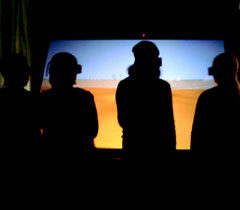Augmenting Elementary School Education with VR
March 1st, 2002
Categories: Applications, Education, Multimedia, VR

Authors
Johnson, A., Moher, T., Cho, Y., Lin, Y., Haas, D., Kim, J.About
We believe that using a virtual world to teach scientific investigation can be beneficial in preparing elementary school students for doing these sorts of investigations in the real world.
The students can explore environments that aren’t locally accessible and measure phenomena they wouldn’t normally be able to. More importantly, a teacher can simplify the complexity of the world to focus on particular features.
At the University of Illinois at Chicago’s Electronic Visualization Laboratory, we use virtual reality technology to complement real-world experiences rather than replace them. For more than two years, we’ve been deploying ImmersaDesk applications in a Chicago-area elementary school. We want to know whether these virtual environments (VEs) help children make sense of mathematics and scientific phenomena. If so, can educators adapt them to the realities of elementary school learning and teaching?
Our experience indicates that VR can successfully augment scientific education as well as help to equalize the learning environment by engaging students of all levels.
Resources
URL
Citation
Johnson, A., Moher, T., Cho, Y., Lin, Y., Haas, D., Kim, J., Augmenting Elementary School Education with VR, IEEE Computer Graphics and Applications, vol 22, no 2, pp. 6-9, M. Macedonia|L. Rosenblum, March 1st, 2002. http://www.computer.org/cga/cg2002/pdf/g2006.pdf